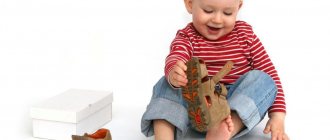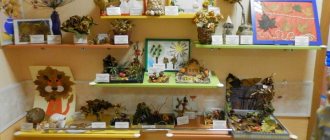Consultation for parents “Safety of preschoolers”
Brief description of the document:
CONSULTATION FOR PARENTS
"PRESCHOOL CHILDREN'S SAFETY"
Consultation on life safety for kindergarten parents
The main advantage of preschoolers in teaching personal safety is that children of this age follow clearly formulated instructions from their parents in connection with age-related characteristics. It is necessary to highlight the rules of behavior that children will follow, since their health and safety depend on this. These rules should be explained in detail to children and then monitored for their implementation. The task of adults is not only to protect and protect the child, but also to prepare him to face various difficult and sometimes dangerous life situations. The child must know information about himself : first name, last name, address and telephone number.
Mark the “friend-stranger” : set rules regarding strangers and monitor their implementation. Explain to your child: a stranger is any person he does not know (regardless of how he behaves or who he imagines himself to be). To form a more accurate understanding of who is “your” and “stranger” people, ask them to depict in one drawing those people whom they consider “theirs” (mom, dad, grandmother, etc.), and in another drawing - strangers, strangers (seller, passerby, etc.). If the child depicted someone else in the first picture, in addition to family members, for example: a teacher, a mother’s friend, a friend, explain that such people are called “acquaintances.” Offer to draw them in the third picture. It wouldn't hurt to run a few learning experiments to test your understanding of these rules. For example, a mother or father can agree with an acquaintance whom the child does not know so that he tries to get to know the baby and invites him to come with him. After the experiment, of course, you need to discuss with the child his reaction. If the child is left alone at home: he must clearly understand that the door cannot be opened to ANYONE except his mother (father, grandmother - specify the circle of people). Household items that are sources of potential danger to children are divided into three groups: - items that are strictly prohibited to use (matches, gas stoves, sockets, turned on electrical appliances); - objects that, depending on the age of the children, need to be learned to handle correctly (needle, scissors, knife); - items that adults should store in places inaccessible to children (household chemicals, medicines, alcoholic beverages, cigarettes, cutting and stabbing instruments).
If a fire occurs in the absence of adults, it is important for the child to know the following: - do not hide under the table, in the closet or under the bed (firefighters may not immediately notice the child and may not have time to save him); - If possible, run out onto the balcony or look out the window and scream for help.
When preparing your child to go to school independently or ride a bike in the yard, you should walk around the entire yard with him, noting potentially dangerous places.
Make an agreement with your child, according to which he will only move along the safe route agreed with you and will not take shortcuts, especially in desert areas. This agreement is the basis of street safety. The child must remember the following rules. 1.Do not go outside without adults.
2.Do not play on the sidewalk near the roadway. 3. Cross the road only at a pedestrian crossing when the traffic light is green. 4. Ride a bicycle in the city only where there are no cars. 5. Small children should ride a bicycle only in the presence of adults; children of older preschool age, even in the presence of adults, should not ride a bicycle on the sidewalk, as they can interfere with pedestrians, run over a small child, hit an elderly person, push a stroller with a baby .
6.Be attentive, but not overly cautious or cowardly.
7. It’s good to know the landmarks in the area of your home. 8.Walk in the middle of the sidewalk, avoiding bushes and doors, especially abandoned houses. 9.Know all the safe places where you can hide and get help. 10.Do not attract attention to yourself by your demeanor.
Safety in public transport
Parents should remember that young children should not travel on public transport without an adult. But gradually children need to be prepared for this. For example, the child should know his route well, mainly the pick-up and drop-off stations. He must also know all the landmarks and street names along the route. Explain to your child that he must see and notice everything.
Advise your child to sit next to the driver or controller and wait for the bus only in a well-lit place. Of course, strengthen your child’s faith in his own instinct. He should leave as soon as he feels any discomfort. If a stranger speaks to him, he needs to attract the attention of others so that if necessary, someone can come to his aid. When using public transport, the following rules must be observed. 1. You cannot show money to attract attention. 2. You cannot go close to the edge of the road when boarding a bus, especially during icy periods. 3. You cannot stand at the doors - this interferes with the entry and exit of passengers. 4.You cannot lean out or stick your hands out of open windows. 5. It is customary to give way to elderly people, passengers with small children, and disabled people. “Road Safety” You can cross the street only at pedestrian crossings. They are indicated by a special sign “Pedestrian crossing”
If there is no underground crossing, you must use a crossing with a traffic light. Outside populated areas, children are only allowed to walk with adults along the edge towards cars. If your parents have forgotten which side to go around a bus or tram, you can remind them that it is dangerous to go around these vehicles both in front and behind. You need to go to the nearest pedestrian crossing and cross the street along it. Under no circumstances should you run out onto the road. You have to stop before the road. You cannot play on the roadway or on the sidewalk. It is safest to cross the street in a group with a group of pedestrians. When the car is moving: — teach children to sit in the car only in the back seat; do not allow anyone to sit next to the driver unless the front seat is equipped with a child seat; — do not allow a small child to stand in the back seat while driving: in the event of a collision or sudden stop, he may fly over the back of the seat and hit the front window; - Do not allow children to be in the vehicle unattended.
The best way to teach children has always been by example. If you want to teach your child safety rules, first of all, follow them yourself. Talk to your children as often as possible and help them solve even minor problems.
Safety tips for parents
Dear parents! You are a role model for children. You are an object of love and imitation for a child. This must always be remembered, and even more so when you take a step onto the roadway with your baby.
To prevent your child from getting into trouble, teach him respect for the rules of the road patiently, daily, unobtrusively. The child should only play in the yard under your supervision. He must know: you can’t go out on the road. Do not intimidate the child, but watch with him and take advantage of the situation on the road, yard, street; Explain what happens to transport and pedestrians. Develop your child's visual memory and attention. To do this, create game situations at home. Let your baby lead you to kindergarten and home from kindergarten. Your child should know: you can’t go out on the road; You can cross the road only with adults, holding the hand of an adult; you need to cross the road at a calm pace; pedestrians are people walking along the street; in order for there to be order on the road, so that there are no accidents, so that a pedestrian does not get hit by a car, you must obey the traffic light: red light - no traffic, yellow light - attention, and green says: “Pass the path is open”;
There are different types of cars (trucks, cars); this is transport. The cars are driven by drivers. The highway (road) is intended for transport. When we travel in public transport, we are called passengers. While riding in public transport, you should not lean out of the window.
Consultation for parents “Basics of life safety for preschool children”
Consultation for parents
“Fundamentals of
life safety for preschool children ”
Prepared by teacher Bondarenko Ekaterina Alekseevna
According to statistics, the most common reasons that pose a threat to the life and health of children are accidents. At preschool age, children, possessing immoderate curiosity, energy and imagination, very often find themselves in very serious situations. Children cannot accurately assess the consequences of their research. Preschoolers, as a rule, very much want to know “what will happen if...”, while they cannot imagine the occurrence of a danger to their life and health. Children are obviously sure that any of their actions is normal. Their interest in everyday things that “yesterday” did not attract attention to themselves can end in failure. According to disappointing data, several hundred thousand cases of children injured in accidents at home are registered annually.
Why do accidents happen?
Children left without proper supervision become a danger to themselves. In modern life, adults have a large number of responsibilities and tasks that need to be completed while looking after their children. Left to their own devices, even for a few minutes, children are capable of causing a “catastrophe.” After all, they do not realize that they can harm themselves; they do not yet have life experience.
Accident Prevention
So that your child, and if he is not alone, then the risk of dangerous situations increases many times over, does not create a threat to his health, or even life, it is necessary to conduct an audit of the places accessible to the baby. Squat down and look from his height at the entire surrounding space. A plugged-in electric kettle is a very common source of scalding children with boiling water. The lids and handles of the dishes sparkle on the stove, and there is a chair next to it. There is a 100% guarantee that he will be pushed up to the stove to see what is happening there. Even if before this time, your child has never climbed onto a chair, it is when there are no adults nearby that this will happen. The same chair may also be next to the bedside table, in the drawer of which there are such attractive things: nails, screws, screwdrivers. The baby can put all this in his mouth and prick himself. And how many el. Burns from nails getting into the holes of electrical sockets happen to kids every day! Not to mention electrical injuries from extension cords, of which there are quite a few in every home.
Open the cabinets with household chemicals and other “interesting” beautiful bottles. Chemical burns in children are not uncommon.
Alcohol, cigarettes, medications - all are a threat to the life and health of a child. A child's games of being a grandma who takes pills at night, or a dad who drinks beer in front of the TV, brings him to the intensive care unit. Don’t expect that children cannot discover something; their ingenuity and imagination know no bounds.
The task of adults is, first of all, to remove from the child’s reach (including from a chair or windowsill, table, bedside table) any things that can be knocked over, poured on oneself, or stuck somewhere (a nail in a socket, a pea in the nose, swallowing a needle and etc.), eat or drink, as well as matches, which are difficult to light only in our hands. The life and health of your child depend primarily on your precautions and reinsurance.
Precise instructions are the key to children's safety
Most preschoolers, due to their age and development, follow clearly defined instructions. This means you need to explain to children in detail what needs to be done in certain situations and monitor their compliance. After all, the task of parents is not only to save and protect, but also to prepare children for various non-standard, difficult, and often dangerous life situations.
The child must know information about himself:
first name, last name, address and telephone number.
Then clearly define “friend or foe” for the child.
Explain to your child:
a stranger is any person he does not know (regardless of how he behaves or who he introduces himself to be). Especially pay his attention to the circumstance when a stranger offers him to catch a bird, give him a chocolate bar or ride in a car. Explain to your child that only bad people do this, they want harm to children. And then there are our own: mom, dad, grandparents, etc. and just acquaintances: a neighbor who comes to visit her grandmother, a friend of her mother, friends of her father or older brother, kindergarten teachers, etc. Explain to him, if he is left at home alone, who can open the door and who cannot.
To strengthen the child’s understanding of who is “their own”, who
“strangers”, and some “familiar”, invite him to draw them in separate drawings. Focus on the fact that “acquaintances” are also not “your own” and you cannot open doors for them or agree to go for a walk or ride with them
.
Having sorted people into “classes,” the child will learn exactly which of them belongs to which category.
Another
aspect the threat to life is the occurrence of a fire.
The child must clearly know what not to do in this case: hide under the table, in the closet or under the bed, in the closet. If he is not alone at home, and there is a fire or heavy smoke in the room, he should immediately call an adult. If he himself can open the door to the playground or to the street, he must open the door and call for help with a loud cry. After all, with an adult
Trouble can also happen and the child’s actions can save not only him, but also the adult.
And if the child is alone in the apartment, then, if possible, you should open a window or balcony and call for help, or even better, run out onto the playground or street.
When preparing your child to go to school independently, you need to go through the entire route with him several times, marking all potentially dangerous places. Agree with your child that he will always walk only this route, never deviating from it, in company with friends or taking a shortcut through a deserted place. Explain to him the dangers of such changes.
If you decide that your child can walk in the yard on his own or ride a bike there, also check the entire territory and places where you can ride. After all, apart from various dark nooks and crannies, all the courtyards are full of cars. And even the most attentive driver can cause a collision if a small cyclist gets into the “blind visibility zone”.
The child must remember the following rules.
- Don't go outside without adults.
- Do not play on the sidewalk near the roadway.
- Cross the road only at a pedestrian crossing when the traffic light is green.
- Ride a bicycle in the city only where there are no cars.
- Small children should ride a bicycle only in the presence of adults; children of older preschool age, even in the presence of adults, should not ride a bicycle on the sidewalk, as they can interfere with pedestrians, run over a small child, hit an elderly person, or push a stroller with a baby.
- Be careful, but not overly cautious or cowardly.
- It's good to know the landmarks in your area.
- Walk in the middle of the sidewalk, avoiding bushes and doors, especially abandoned houses.
- Know all the safe places where you can hide and get help.
- Do not attract attention to yourself with provocative behavior.
Safety in public transport
Parents should remember that young children should not travel on public transport without an adult. But gradually children need to be prepared for this. For example, the child should know his route well, mainly the pick-up and drop-off stations. He must also know all the landmarks and street names along the route. Explain to your child that he must see and notice everything.
Advise your child to sit next to the driver or controller and wait for the bus only in a well-lit place. Of course, strengthen your child’s faith in his own instinct. He should leave as soon as he feels any discomfort. If a stranger speaks to him, it is best for him to approach an adult and ask for protection.
When using public transport, the following rules must be observed.
- You cannot show money to attract attention.
- You should not come close to the edge of the road when boarding a bus, especially during icy periods.
- You cannot stand at the doors - this interferes with the entry and exit of passengers.
- You cannot lean out or stick your hands out of open windows.
- It is customary to give up your seat to elderly people, passengers with small children, and people with disabilities.
Safety on the roads
It is best to cross the street using underground or overground pedestrian crossings; if there are none, then it is very advisable to use a crossing with a traffic light. And only as a last resort, use an unregulated pedestrian crossing with painted stripes on the asphalt. In this case, you must make sure that drivers notice the pedestrian and slow down.
Outside populated areas, children are only allowed to walk with adults along the edge towards cars.
The child must be told that it is dangerous to walk around a trolleybus or tram both from the front and from the back. You need to go to the nearest pedestrian crossing and cross the street along it.
Under no circumstances should you run out onto the road. You must stop before the road, even if the light is green, you must walk at a normal pace, and not run. After all, when running, it is difficult to assess a sudden danger.
You cannot play on the roadway or on the sidewalk.
It is safest to cross the street in a group with a group of pedestrians.
When the car is moving:
- teach children to sit in the car only in the back seat; do not allow anyone to sit next to the driver unless the front seat is equipped with a child seat;
- Do not allow a small child to stand in the back seat while driving: in the event of a collision or sudden stop, he may fly over the back of the seat and hit the front window;
- Do not allow children to be in the vehicle unattended.
The best way to teach children has always been by example. If you want to teach your child safety rules, first of all, follow them yourself. Talk to your children as often as possible and help them solve even minor problems. And be sure to discuss all situations that arise on the road with you or other people.
Dear parents!
You are a role model for children. You are an object of love and imitation for a child. This must always be remembered, and even more so when you take a step onto the roadway with your baby. To prevent your child from getting into trouble, teach him to respect the rules
traffic patiently, daily, unobtrusively. Create games based on the road situations you have seen, invite your child to take you to kindergarten and back, this will allow him to remember the road better. Your
child must clearly understand:
- You cannot go out onto the road outside the designated pedestrian crossing;
- You can cross the road only with adults, and if he walks on his own, then only at a calm pace;
- pedestrians are people who walk along the street and he is also a pedestrian;
- in order for there to be order on the road, so that there are no accidents, so that a pedestrian does not get hit by a car, you must obey the traffic light: you must stand at red, get ready for yellow, and only green light gives permission to cross;
- There are different types of cars (trucks, cars) - this is transport. Cars are driven by drivers who drive on the roads, and pedestrians walk on the sidewalk;
Pedestrians traveling in any vehicle become passengers. While riding in public transport, you should not lean out of the window, run, shout, etc.
The sooner you start telling your child about all the nuances of behavior at home and on the road, the better the child will learn this and the more protected he will be from threats to his health and life.



